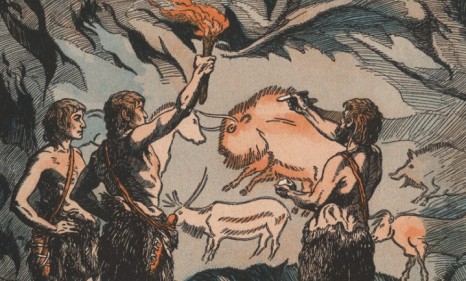Have scientists unearthed the first 'gay caveman'?
Archaeologists in the Czech Republic uncover the 5,000-year-old remains of what they think is the world's oldest known homosexual caveman

A gay caveman might sound like a character in a bad, vaguely offensive sketch comedy scene, but for some scientists in the Czech Republic, it's no laughing matter. They believe they've unearthed the remains of an early homosexual or transsexual man — perhaps the world's oldest gay caveman. Here, a brief guide:
What exactly did the scientists find?
In a suburb of Prague, archaeologists unearthed a male body buried in a manner typically reserved for women. The body dates back to between 2900 and 2500 B.C. The skeleton was surrounded by jugs and had its head pointed toward the east, things seen before only in the graves of women. "From history and ethnology, we know that people from this period took funeral rites very seriously, so it is highly unlikely that this positioning was a mistake," says Kamila Remisova Vesinova, the lead archaeologist on the dig. "Far more likely is that he was a man with a different sexual orientation, homosexual or transsexual."
The Week
Escape your echo chamber. Get the facts behind the news, plus analysis from multiple perspectives.

Sign up for The Week's Free Newsletters
From our morning news briefing to a weekly Good News Newsletter, get the best of The Week delivered directly to your inbox.
From our morning news briefing to a weekly Good News Newsletter, get the best of The Week delivered directly to your inbox.
How were men typically buried in that time period?
Their heads were aligned pointing west, and they were surrounded by weapons and tools, as well as food and drink. By contrast, women were buried with domestic items, such as jugs, as well as jewelry, and a pot in the shape of an egg at their feet. This caveman's skeleton had such a pot at his feet.
Are they sure about this?
The scientists who unearthed the skeleton seem fairly certain that he was a homosexual or transsexual. Others are a bit doubtful. Rosemary Joyce, a social science professor at the University of California, Berkeley, isn't buying the gay caveman story. This is just another in a series of "sensationalized archaeology stories," Joyce says at her Ancient Bodies, Ancient Lives blog, and it's an "example of sexual stereotyping of the worst kind." Scientists have indeed found "a mismatch between the biologically determined sex of the person and the archaeologically expected grave goods," but that doesn't mean he was gay, or even a caveman — a term "no archaeologist wants to use."
A free daily email with the biggest news stories of the day – and the best features from TheWeek.com
Have scientists ever found anything like this before?
Not quite. Katerina Semradova, another scientist on the dig, does cite an earlier case where archaeologists found a female warrior from the Mesolithic period (10,000 to 8,000 B.C.) who was buried as a man. Witch doctors were also buried in a unique way, with richer funeral adornments, noting their respected position in society. But, says Semradova, "this later discovery was neither of those," which leaves his sexuality as the best explanation for his unusual burial.
So what does it all mean?
The findings suggest "that LGBT individuals were living open and accepted lives as far back as the Stone Age," says Seth Abramovitch at Gawker. And, he jokes, "it also means that we have finally unlocked the elusive key to carbon-dating Cher."
Sources: Telegraph, Gawker, Ancient Bodies, Ancient Lives, Answers.com
-
 Venezuela’s Trump-shaped power vacuum
Venezuela’s Trump-shaped power vacuumIN THE SPOTLIGHT The American abduction of Venezuelan President Nicolás Maduro has thrust South America’s biggest oil-producing state into uncharted geopolitical waters
-
 Most data centers are being built in the wrong climate
Most data centers are being built in the wrong climateThe explainer Data centers require substantial water and energy. But certain locations are more strained than others, mainly due to rising temperatures.
-
 ‘Maps are the ideal metaphor for our models of what the world might be’
‘Maps are the ideal metaphor for our models of what the world might be’Instant Opinion Opinion, comment and editorials of the day